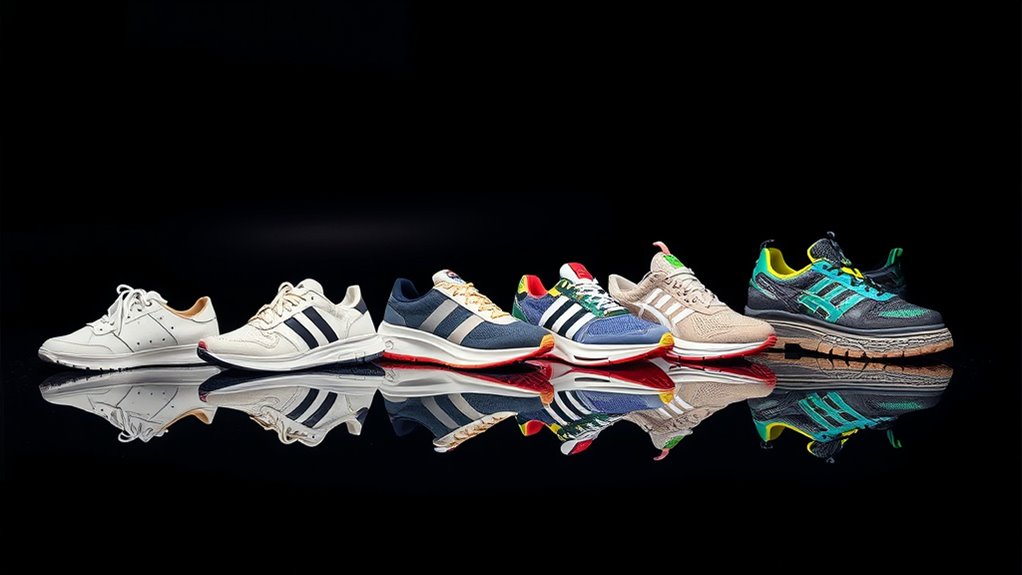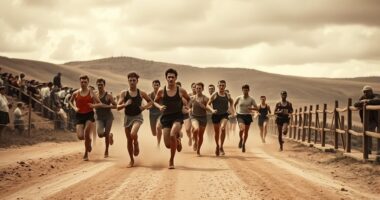Starting with simple rubber-soled plimsolls, running shoes evolved through innovations like foam midsoles in the 1970s that improved shock absorption, to modern supershoes featuring carbon plates and advanced foams that enhance energy return and speed. Fitting methods became more sophisticated, reducing discomfort and injury. These technological leaps have drastically changed marathon strategies and performance. Keep exploring to discover how these innovations continue shaping running into the future.
Key Takeaways
- Early running shoes resembled simple rubber-soled sneakers prioritizing durability over comfort.
- Foam midsole technology emerged in the 1970s, enhancing shock absorption and energy return.
- Advances in foot analysis and fitting techniques improved comfort, reducing injuries and boosting performance.
- Modern shoes incorporate carbon plates and advanced foams, revolutionizing marathon race strategies and record-breaking.
- Integration of biomechanics and materials science continues to drive innovations in performance and aesthetics.

Have you ever wondered how running shoes have evolved over the years? The journey from simple plimsolls to high-tech supershoes is remarkable, and understanding this progression can give you a new appreciation for the shoes you wear. When training for marathons, your choice of footwear can considerably impact your performance, and knowing the history behind shoe technology helps you make smarter decisions. For example, marathon race strategies often hinge on selecting shoes that balance weight, cushioning, and energy return, all of which have been refined over decades. Early running shoes focused mainly on durability, but as races grew longer and faster, athletes and manufacturers started emphasizing comfort and efficiency. Shoe fitting techniques also advanced, moving beyond basic measurements to detailed analyses that consider foot shape, arch type, and gait patterns. This evolution allowed runners like you to optimize performance and reduce injury risks.
In the early 20th century, running shoes resembled simple rubber-soled sneakers, offering little support or cushioning. As running gained popularity, especially after the 1960s, shoe companies began experimenting with materials and designs to improve comfort and speed. The advent of foam midsole technology in the 1970s marked a noteworthy milestone, providing better shock absorption and energy return. This innovation directly influenced marathon race strategies, enabling athletes to run faster and longer without excessive fatigue. With these advancements, shoe fitting techniques also improved; instead of just measuring foot length, specialists started analyzing foot width, arch height, and pronation. This tailored approach helped runners find shoes that fit perfectly, boosting confidence and reducing blisters or discomfort during long-distance races. Additionally, the incorporation of color accuracy in design and branding became increasingly important for manufacturers aiming to appeal to athletes and consumers alike.
The 21st century saw the rise of lightweight, performance-oriented shoes designed specifically for racing. Brands introduced carbon plate technology and advanced foam compounds to maximize propulsion and minimize weight. These supershoes revolutionized marathon race strategies, allowing elite runners to break records and pushing the boundaries of human performance. Meanwhile, shoe fitting techniques became increasingly sophisticated with the advent of 3D foot scanning and gait analysis, making it easier for you to find the perfect fit regardless of foot shape or running style. Today’s shoes are a product of decades of innovation, blending biomechanics, materials science, and athlete feedback. By understanding this timeline, you can better appreciate how each technological leap impacts your running experience, whether you’re training for a marathon or just running for fitness. Choosing the right shoes now involves knowing their history, ensuring you benefit from the best design features crafted through years of research and development.
Frequently Asked Questions
How Do Different Shoe Materials Impact Running Performance?
Different shoe materials impact your running performance by influencing durability and moisture management. Durable materials like reinforced mesh or synthetic uppers withstand wear and tear, keeping your shoes supportive longer. Lightweight, breathable fabrics help wick moisture away, keeping your feet dry and comfortable during runs. These factors boost your efficiency, prevent blisters, and enhance overall comfort, allowing you to run better and longer. Choosing the right materials makes a noticeable difference in your performance.
What Are the Environmental Effects of Modern Running Shoe Manufacturing?
Like a ripple spreading across a pond, modern shoe manufacturing impacts the environment. You should know that using sustainable materials helps reduce manufacturing emissions, lessening pollution and conserving resources. However, the production process still contributes to carbon footprints. By choosing brands committed to eco-friendly practices, you can lessen your environmental impact, making your run not just good for you but also for the planet.
How Do Custom Insoles Influence Running Efficiency?
Custom insoles improve your running efficiency by providing personalized cushioning that absorbs shock and reduces fatigue. They also enhance biomechanical alignment, helping your foot move naturally and efficiently. By supporting your arch and heel precisely, these insoles can improve your stride, reduce injury risk, and boost overall performance. With tailored comfort and better alignment, you run smoother and more efficiently, making each workout more effective and enjoyable.
What Future Innovations Are Expected in Running Shoe Technology?
You can expect future running shoe innovations to focus on sustainable materials and advanced biomechanical design. Shoe brands will likely incorporate eco-friendly fabrics and recycled components to reduce environmental impact. Additionally, they’ll optimize biomechanical structures to enhance your running efficiency, providing better support and energy return. These advancements aim to make your runs more comfortable, eco-conscious, and performance-driven, pushing the boundaries of what’s possible in running shoe technology.
How Does Shoe Technology Vary Across Different Running Disciplines?
You know what they say, “Different strokes for different folks.” When it comes to running disciplines, shoe technology varies markedly. For sprinters, you focus on lightweight shoes with minimal cushioning and a streamlined heel design for speed. Marathon runners prefer shoes with enhanced shoe cushioning for comfort over long distances and a heel design that offers stability. Trail runners seek rugged soles and ankle support, adapting shoe tech to their specific needs.
Conclusion
As you’ve seen, running shoe technology has come a long way, transforming your runs from basic comfort to high-performance gear. With innovations like lightweight materials and energy-returning midsoles, every step gets better. So, next time you lace up, ask yourself—are you ready to see what the future of running shoes holds? Embrace the progress and keep pushing your limits, because the best is yet to come.









